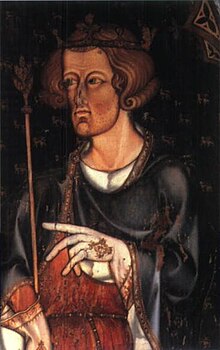Lord Paramount of Scotland
| Edward I | |
|---|---|

Portrait in Westminster Abbey, thought to be of Edward I
|
|
| King of England (more...) | |
| Reign | 16 November 1272 – 7 July 1307 |
| Coronation | 19 August 1274 |
| Predecessor | Henry III |
| Successor | Edward II |
| Born | 17/18 June 1239 Palace of Westminster, London, England |
| Died | 7 July 1307 (aged 68) Burgh by Sands, Cumberland, England |
| Burial | 27 October 1307 Westminster Abbey, London, England |
| Spouse |
Eleanor of Castile (m. 1254–1290) Margaret of France (m. 1299–1307) |
| Issue among others |
Eleanor, Countess of Bar Joan, Countess of Hertford Alphonso, Earl of Chester Margaret, Duchess of Brabant Elizabeth, Countess of Hereford Henry Edward II of England Thomas, Earl of Norfolk |
| House | Plantagenet |
| Father | Henry III of England |
| Mother | Eleanor of Provence |
Edward I (17/18 June 1239 – 7 July 1307), also known as Edward Longshanks and the Hammer of the Scots (Latin: Malleus Scotorum), was King of England from 1272 to 1307. He spent much of his reign reforming royal administration and common law. Through an extensive legal inquiry, Edward investigated the tenure of various feudal liberties, while the law was reformed through a series of statutes regulating criminal and property law. Increasingly, however, Edward's attention was drawn towards military affairs.
As the first son of Henry III, Edward was involved early in the political intrigues of his father's reign, which included an outright rebellion by the English barons. In 1259, he briefly sided with a baronial reform movement, supporting the Provisions of Oxford. After reconciliation with his father, however, he remained loyal throughout the subsequent armed conflict, known as the Second Barons' War. After the Battle of Lewes, Edward was hostage to the rebellious barons, but escaped after a few months and joined the fight against Simon de Montfort. Montfort was defeated at the Battle of Evesham in 1265, and within two years the rebellion was extinguished. With England pacified, Edward joined the Ninth Crusade to the Holy Land. The crusade accomplished little, and Edward was on his way home in 1272 when he was informed that his father had died. Making a slow return, he reached England in 1274 and was crowned at Westminster on 19 August.
After suppressing a minor rebellion in Wales in 1276–77, Edward responded to a second rebellion in 1282–83 with a full-scale war of conquest. After a successful campaign, Edward subjected Wales to English rule, built a series of castles and towns in the countryside and settled them with English people. Next, his efforts were directed towards Scotland. Initially invited to arbitrate a succession dispute, Edward claimed feudal suzerainty over the kingdom. In the war that followed, the Scots persevered, even though the English seemed victorious at several points. At the same time there were problems at home. In the mid-1290s, extensive military campaigns required high levels of taxation, and Edward met with both lay and ecclesiastical opposition. These crises were initially averted, but issues remained unsettled. When the King died in 1307, he left to his son, Edward II, an ongoing war with Scotland and many financial and political problems.
...
Wikipedia
